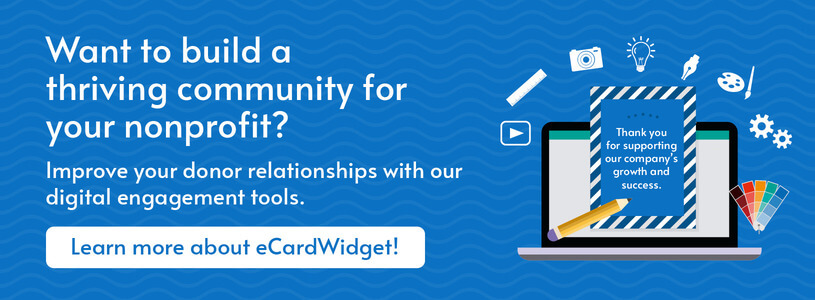Imagine a world where the walls in your nonprofit’s office could talk. They would tell stories of passionate donors who gave their hard-earned money to transform the communities you serve. Among these tales of unwavering support, there would also be whispers of donors who came, gave generously, and disappeared, leaving behind untapped potential for a brighter future.
In the realm of nonprofit fundraising, donor retention is a very real priority. With the right recognition strategies, you can inspire donors to stick around and make your mission a reality.
Donor relationships require special care, and learning how to retain those connections will unlock sustainable growth. To help you cultivate lasting relationships, we’ll share everything you need to know about donor retention, including the following topics:
- What Is Donor Retention?
- Why Does Your Nonprofit’s Donor Retention Matter?
- How to Calculate Donor Retention Rate
- Donor Retention FAQ
- 9 Donor Retention Strategies to Cultivate Stronger Relationships
- Using eCards To Improve Your Donor Retention Rate
Ready to uncover the power to inspire continued support and ensure your organization’s mission thrives like never before? Let’s dive in.

What Is Donor Retention?
Donor retention refers to the strategies and efforts a nonprofit implements to encourage donors to continue their support over an extended period of time. When you inspire a one-time donor to give again, you’ve retained that donor.
Retention focuses on cultivating strong, long-term relationships with donors, ensuring they remain engaged, satisfied, and committed to the organization’s mission. It includes activities that foster engagement, such as sending recognition gifts and sharing other involvement opportunities.
While a nonprofit with a high donor retention rate has several donors who return each year, a nonprofit with a low donor retention rate struggles to inspire donors to continue giving. By successfully retaining donors, nonprofits secure consistent and sustainable funding, foster loyalty, and increase the overall impact of their programs and initiatives.
Why Does Your Nonprofit’s Donor Retention Matter?
Much like businesses need to motivate employees and customers to stay, your nonprofit will need to motivate donors to continue giving.
Retained donors are fully committed to supporting your cause. Their regular gifts and consistent support provide many benefits to your nonprofit, such as:
- Cost efficiency: Donor retention has a high ROI since it costs less to retain donors than it does to acquire them. Neon One estimates that the average cost to retain a donor is only $0.20 for every $1 given. A lot of time, energy, and resources go into marketing and converting new leads into donations. By focusing on individuals already interested in your organization, you can reduce acquisition costs.
- Future-proofed operations: Since retained donors make regular gifts to your nonprofit, you can count on them as a consistent source of revenue for the future.
- Stronger donor relationships. By engaging with your donors, you’ll see improved satisfaction and happiness. You’ll also have a better reputation as a nonprofit that truly cares about its supporters.
Ideally, you’ll want high donor retention and low donor attrition. The latter refers to the number of donors that stop giving, such as one-time donors. To help you weigh donor retention and attrition and make the appropriate adjustments to your strategies, you’ll need to calculate your donor retention rate.
How To Calculate Your Donor Retention Rate
Knowing how to calculate your nonprofit’s donor retention rate is essential. It provides valuable insights into the effectiveness of your fundraising efforts and the health of your donor relationships. Luckily, most CRMs will calculate this metric for you. However, it’s important to know how to calculate it manually.
To calculate your donor retention rate for the current year, divide the number of donors from the previous year that gave again in the current year by the total number of donors from the previous year, and then multiply by 100 to get a percentage. Keep this formula on hand to regularly check on your donor retention rate:
Donor Retention Rate = Number of Repeat Donors This Year / Number of Donors Last Year x 100

For example, let’s say you had 500 donors last year, and 300 of them gave again this year. In that case, your donor retention rate would be 60%.
Having a high donor retention rate means that more of your donors are returning to make a gift to your nonprofit every year. As a result, you’ll be able to raise the same amount of funds as in previous years while attracting fewer donors. To improve your donor retention rate, re-evaluate your strategies and analyze key performance indicators (KPIs) to determine where your current strategy may be lacking.
How to Calculate Donor Lifetime Value
On a similar note, let’s explore how to calculate donor lifetime value (LTV). LTV is a projection of the value of a donor before they stop giving, and it helps make crucial decisions about your nonprofit marketing efforts and appeals. For example, you’ll know how much you can invest in marketing campaigns to acquire new donors.
To calculate LTV, you’ll need three key metrics:
- Donor lifespan, which is the duration of the average donor’s relationship with your nonprofit
- Average donation amount, which refers to the average gift size across all donors
- Frequency of donation, which is calculated by dividing the total number of donations by the number of donors within a specific time period. For example, if your nonprofit received 600 donations from 300 donors in a year, your frequency of donation would be 2. That means each donor is donating twice on average.
From here, the LTV formula is simple.
LTV = Lifespan x Average Donation Amount x Frequency of Donation
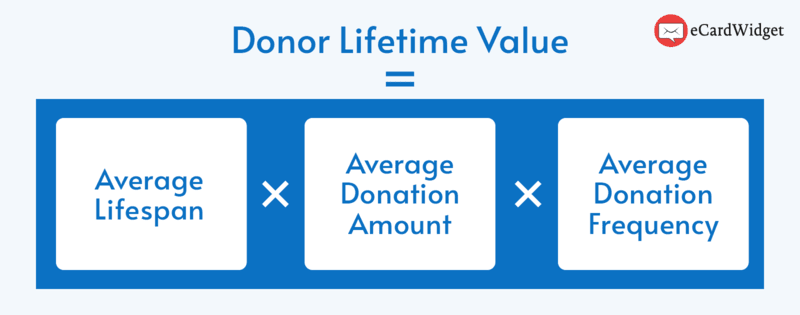
Knowing your donor LTV can inform various aspects of your fundraising and donor stewardship strategies. For example, segment your LTV by giving level or acquisition channel. Then, focus on cultivating relationships with high-LTV donors and tailor your engagement strategies to resonate with each group’s giving behavior.
Donor Retention FAQ
Before diving into specific strategies, let’s take some time to review the fundamentals of retaining donors. These are some of the most common questions nonprofit fundraisers have about the topic:
What is the difference between donor retention and acquisition?
While donor retention refers to how your nonprofit engages donors and inspires continued support, donor acquisition refers to the activities that go into acquiring a first donation from an individual.
The primary goal of donor retention is to build long-term relationships with donors and foster loyalty to the organization. Meanwhile, the primary focus of donor acquisition is to broaden the organization’s donor base and bring in fresh financial support. This involves various marketing and outreach efforts to engage potential donors, educate them about the mission, and persuade them to make an initial contribution.
Donor retention and acquisition are two distinct strategies in nonprofit fundraising aimed at cultivating support, but they focus on different stages of the donor lifecycle.
What is a good donor retention rate?
In the nonprofit industry, the average donor retention rate is 35.4%, according to Fundraising Report Card. This means that if your nonprofit has a higher retention rate than 35.4%, you’re doing better than the average nonprofit.
We can break down these industry average rates further for additional insight into your nonprofit’s performance, too. For example, the industry’s first-time donor retention rate is 20.11%, so out of every 100 first-time donors last year, 20 will be retained this year. Repeat donors have a higher retention rate of 56.05%. So, out of every 100 donors who were already retained last year, 56 will be retained again this year.
In other words, that second “golden” donation is essential. Once you inspire a first-time donor to give again, they’re more likely to stick around. Compare these industry numbers to your nonprofit’s metrics to gauge how well your nonprofit retains support.
How does donor retention vary across donor segments?
According to The Fundraising Effectiveness Project’s Quarterly Fundraising Report, here’s how donor retention varies across different segments:
- Micro: These individuals give under $100 and have a retention rate of 32.2%.
- Small: Donors who give between $101-$500 have a retention rate of 51.5%.
- Midsize: These donors give between $501-$5K and have a retention rate of 62.8%.
- Major: These individuals give between $5K-$50K and have a retention rate of 67%.
- Supersize: Donors who give $50K+ have a retention rate of 67.9%.
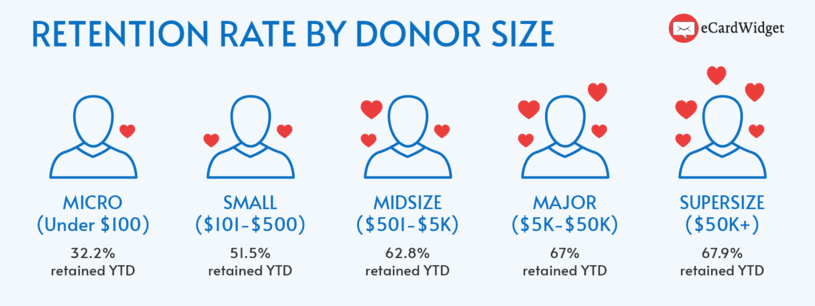
Take a look at your own donors. How does your donor retention rate compare to the industry’s averages for different segments? Chances are, your numbers probably look similar to these. Note that the amounts that qualify donors as “micro,” “small,” ” midsize,” and so on differ across organizations.
If your retention rates are lower for particular segments, determine if you’re devoting enough attention to those segments. Compare your retention activities for those particular donors to the segments that have higher rates. Are you doing anything noticeably different that you can apply to other segments to boost retention?
What causes donors to lapse?
When a nonprofit fails to secure another donation from an individual within a certain period of time, that’s known as donor lapse. There are a handful of reasons why donors lapse, such as:
- Lack of personalized communication: Donors want to form genuine connections with your team. Without tailored interactions, they may feel disconnected and less motivated to give again.
- Insufficient impact reporting: Donors need to see the tangible results of their contributions, such as by hearing updates about beneficiaries or projects. Otherwise, they may question the effectiveness of their support and choose not to continue giving.
- Overwhelming solicitation: Constantly bombarding donors with fundraising appeals can lead to fatigue, making them more likely to lapse.
- Lack of acknowledgment: Not recognizing donors’ contributions promptly and genuinely can leave them feeling undervalued and less likely to continue their support.
- Change in financial circumstances: People’s finances change all the time due to economic challenges and job loss. Personal financial changes can force donors to stop giving.
- Shifting priorities: Naturally, donors’ interests and passions can evolve over time, leading them to support different causes.
While some of these reasons are in your control, others aren’t. Overall, the best thing you can do to avoid donor lapse is to keep your donors happy. Let them know that their support is valued, keep them updated on projects they support, and reel them into your beneficiaries’ stories to inspire them to stick around.
9 Donor Retention Strategies to Cultivate Stronger Relationships
In a perfect world, your donor retention rate would be 100%, but that’s nearly impossible to achieve. While that can be disheartening, think of it this way: there’s always room for improvement! Let’s explore some easy-to-implement strategies that will help boost your donor retention rate.
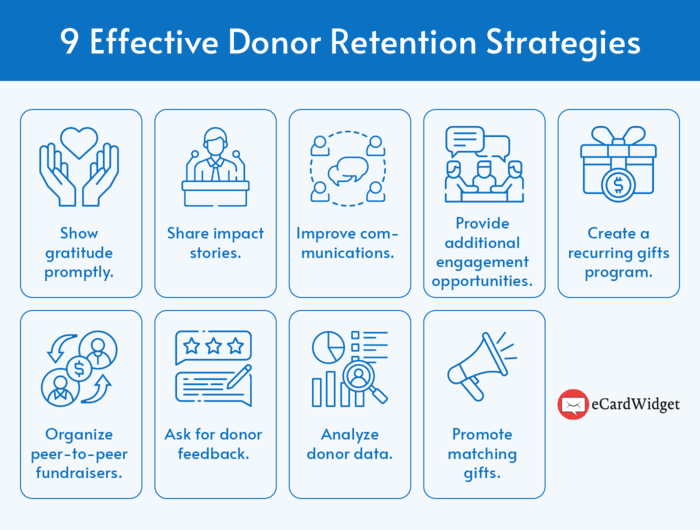
1. Show gratitude promptly.
When you give a friend a gift, you likely want them to appreciate it! Donors have the same feeling toward nonprofits—they want to feel recognized for the gifts they’ve given your organization. And if donors feel valued, then they’ll be more likely to continue supporting your nonprofit.
You can show your gratitude through:
- Phone calls
- Thoughtful thank-you emails
- Handwritten Letters
- Meaningful eCards
- Donor gifts
The key to showing genuine gratitude is promptness. Letting too much time pass will leave donors wondering if their gift was valuable or if you’ve forgotten about them. Regardless of if a donor has joined your membership program or made a one-time gift, send some form of acknowledgment within 24 hours. Follow this with a longer thank-you note expressing to the donor what they’re helping you achieve.
2. Share impact stories.
In your communications and thank-you notes to donors, give concrete and tangible details about the impact you’re driving with their gifts. For example, if your nonprofit works to build shelters for those experiencing homelessness, tell donors about the specific community they’re contributing to. Highlight details such as the materials you’ll need and the time it’ll take to give donors a better understanding of your operations.
Also, consider assigning impact labels to different donation amounts. These labels essentially translate donation amounts into specific results that your beneficiaries receive. For example, if your nonprofit works with animal shelters, you could say that:
- $25 a month can provide food and shelter for an animal
- $75 a month can provide food, shelter, toys, and veterinary check-ups for an animal
- $150 a month can help sponsor foster care services for an animal

Aside from sharing the future benefits of donations, you can also share stories about beneficiaries you’ve already helped. Whether you tell your nonprofit’s stories via video, blog posts, or some other medium, this shows donors that your nonprofit is effective and dedicated to its cause. This strengthens their trust in you to do the work you claim to do. Your effectiveness and ability to complete your goals will encourage donors to continue supporting you, as they are dedicated to helping you make a change.
3. Improve your communications.
Outside of thank-you communications, you should be regularly reaching out to donors. Mix your donation appeals with other messages such as event invitations and program updates. Being transparent with your donors will lead to stronger relationships and greater satisfaction, resulting in a higher donor retention rate.
Additionally, you can personalize your messaging and implement donor segmentation so donors receive communications that they will be more likely to engage with. For example, you can segment your donors by different demographics—for older individuals, you might send letters or emails. For younger audiences that are more technologically savvy, you could create social media posts.
4. Provide more ways to engage with your nonprofit.
You want your donors to feel valued by your nonprofit outside of their gifts. To achieve that, provide them with more ways to engage meaningfully with your nonprofit. Invite them to:
- Events
- Creative holiday fundraisers for everything from Mother’s Day to Christmas
- Volunteer opportunities
- Share testimonials
- Become a member
For major or well-connected donors, you might consider inviting them to become a member of your board. This gives them the opportunity to impact your nonprofit directly and allows them to oversee and improve your operations. This can be a very fulfilling experience for trusted donors. When donors feel significant to your work, they’ll want to continue supporting your nonprofit.
5. Implement recurring gifts.
Recurring gifts are an obvious commitment that donors are making to your nonprofit, signaling to you that they have been retained. These gifts are usually given monthly, and nonprofits usually offer perks to recurring donors. Some perks include:
- Free merchandise
- Discounted tickets
- Early access to purchase tickets for events
- Additional program updates
- Exclusive events or communications
Monthly giving research shows that new donor retention rates average less than 20%, while monthly giving programs see retention rates of over 80% after the first year and 95% after year five. Plus, Classy’s recurring donation data found that these programs inspire the average loyal donor to give four times higher donation amounts than passive donors.
As you can see, implementing a recurring gift program helps you incentivize donors to become recurring donors. Consider what type of donors would be interested in this program and select perks that would appeal to them to increase the chances of converting them into recurring donors.
6. Organize peer-to-peer fundraising campaigns.
Peer-to-peer fundraising campaigns allow donors to take on the role of a fundraiser. If donors choose to participate, you’ll know that they’re invested in your nonprofit—otherwise, they wouldn’t post about you or share information about your cause with their friends and family. Fundraising on behalf of your organization requires them to communicate their passion for your cause, deepening their connection when they publicly share their support.
Not only is peer-to-peer fundraising a great donor retention strategy, but it also doubles as an acquisition tactic. Your current donors will endorse your nonprofit to their peers, inspiring them to get involved. By leveraging social proof, you can successfully widen your reach and connect with new donors. In fact, young donors are more likely to engage in and support a cause if their peers are already doing so, according to 360MatchPro’s fundraising statistics page.
7. Ask donors for feedback.
When it comes to donor retention, don’t be afraid to go back to the source and ask donors for their feedback. Send out donor surveys, inviting people to share insight into their personal connections and satisfaction with your nonprofit. Here are some questions you can ask in your survey:
- How long have you been supporting this nonprofit?
- What motivated you to make your initial donation?
- How satisfied are you with our donor acknowledgment process?
- Is there anything we can do to improve your experience with us?
- Have you attended any of our events? If so, how was your experience?
- Are you satisfied with the frequency and depth of our communications? What could we do better?
- Is there any additional information or feedback you’d like to share?
Not only do these surveys provide you with important information that you can use to improve your donors’ experience, but they also show donors that you value their opinions. Donors who are invested in your nonprofit will want to help you improve, so they’ll be happy to give their feedback.
Easily create a feedback loop with tools like SurveyMonkey, Typeform, or Google Forms. Sharing short questionnaires and encouraging honest responses will impress your donors. They’ll appreciate the opportunity to share what they like about your work and what will get them to stick around for the long haul.
8. Analyze donor data.
Donor data can give you insight into your donors’ behavior. Examine your list of current recurring donors or long-time supporters to identify patterns. This can help you target your communications more effectively.
You can also use this data to assess donors that are at risk of lapsing. Remember the reasons donors lapse that we discussed earlier. Some warning signs might include:
- Reduced engagement. Let’s say a donor who once engaged in your fundraising events, consistently opened your communications, and responded to your attempts to contact them stops doing those things. That’s a sign that they’re not as invested in your nonprofit as they once were.
- Decreased giving. If a donor that once made gifts begins to give less frequently or give smaller amounts than before, they may be withdrawing their support from your nonprofit.
- Life changes. Sometimes, donors lapse for reasons out of your control. For example, if a donor loses their job or suffers a family tragedy, they may choose to focus on their life circumstances, not your nonprofit.
- Negative feedback. If a donor tells you that they don’t feel valued, they no longer feel connected to your nonprofit’s mission, or if they are otherwise dissatisfied with your nonprofit’s programs and communications, they may be at risk of lapsing.
By using the data you’ve collected on your donors to determine if they are at risk of lapsing, you’ll be able to mitigate the risks and encourage them to re-engage with your nonprofit. You can also make changes to your donor engagement strategies to increase donor retention. Even if a donor chooses to stop supporting your nonprofit, you’ll be able to craft targeted communications to convince them to reinvest in your cause.
9. Promote matching gifts.
Chances are, you’ve heard of matching gifts. Companies that offer these popular CSR programs promise to match the donations their employees make to eligible nonprofits. This can make a donor’s initial gift go twice as far!
The problem is that 78% of donors don’t know their companies offer this opportunity, according to matching gift research. Of the remaining 22%, some individuals might be unsure how to request a match from their employers. As a result, an estimated $4-$7 billion in matching gift funds goes unclaimed each year.
Matching gifts can be an incredibly impactful way to improve your donor retention rate. Supporters can strengthen their impact without donating more than they already have. Be sure to promote the opportunity to your donors. To do so effectively, we recommend creating a dedicated matching gift page with instructions for requesting a corporate match, posting about corporate giving on social media, and even following up individually with match-eligible donors.
Using eCards To Improve Donor Retention Rate
Sending an eCard to your donors is essentially like sending a physical thank-you note. It can be personalized, customized, and even interactive for maximum engagement, which makes donors feel appreciated and valued. Just like a physical note, an eCard can serve as a souvenir and a feel-good reminder to donors of the positive impact they’ve made. Plus, eCards are super convenient since they’re virtual, making them eco-friendly and cost-effective.
Best of all, they’re incredibly versatile and can be sent throughout the year. For example, you can send eCards to donors during these times:
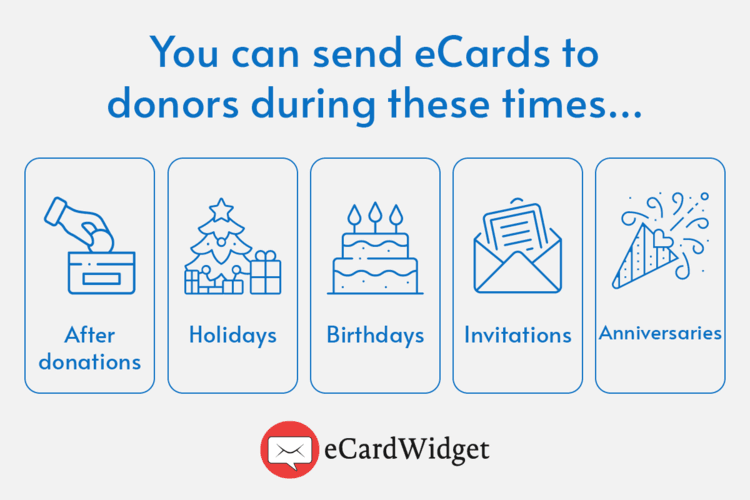
- After donations. Ensure that your donors feel valued with an eCard sent just after they make a gift.
- Holidays. Sending an eCard to your donors for significant holidays such as Christmas is a great way to spread holiday cheer.
- Birthdays. Show your donors that they matter to you by sending them an eCard of good wishes on their special day.
- Invitations. You can invite donors to fundraising events, volunteer opportunities, or to other types of events. For example, Vineyard Church uses eCardWidget to allow its members to invite friends and family to church events.
- Anniversaries. Celebrate your donors’ support by sending them an eCard on the anniversary of their first gift.
Don’t stop at special occasions—you can send eCards anytime! This shows donors that you care about them all the time, fosters a culture of appreciation, and results in a higher donor retention rate. Consider giving donors access to eCards branded to your nonprofit that they can send their friends, too. Your donors will be able to both endorse your nonprofit and send their peers a heartfelt message.
Whether you use them to fundraise or show donors you care, digital greeting cards are a fantastic way to acquire and retain donors. Our tools simplify the design process and make it incredibly easy to use eCards however your nonprofit wants!
Final Thoughts on Donor Retention
To keep donors invested in their cause, it’s crucial for nonprofit organizations to focus on donor retention and stewardship. There are multitudes of ways you can improve your retention strategy, but keep in mind that your approach should be unique to your organization and its donors. Whether that’s through compelling impact stories or eCards, establish your nonprofit as one that genuinely values its supporters.
With a thoughtful approach to engaging your donors, you’ll inspire more people to stick around for the long haul. It’s no secret that we believe digital greeting cards are one of the best ways to cultivate meaningful relationships, so check out our tools to learn more.
In the meantime, enhance your donor retention by exploring these resources:
- Charity eCards for Your Nonprofit: A Comprehensive Guide – Charity eCards are a unique way to set your nonprofit apart from others. Learn more about implementing them as a donor retention strategy with this resource.
- How to Make Every Word Count in A Donation Thank You Letter – Read more about donor thank you letters, a popular donor retention and stewardship strategy.
- A Complete Guide to Employee Recognition + Top 10 Ideas – Your donors contribute a lot, but your employees are equally as crucial to everything your organization does! Check out these ideas to keep your employees happy.
